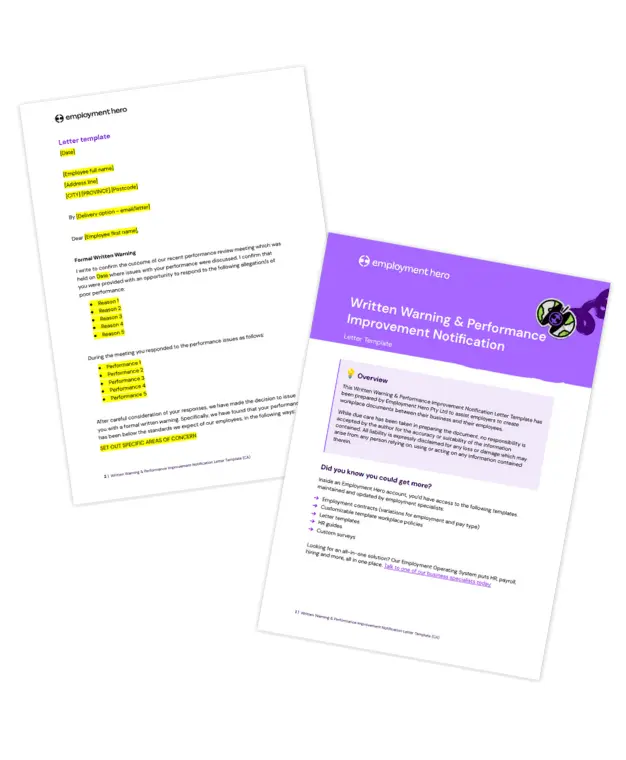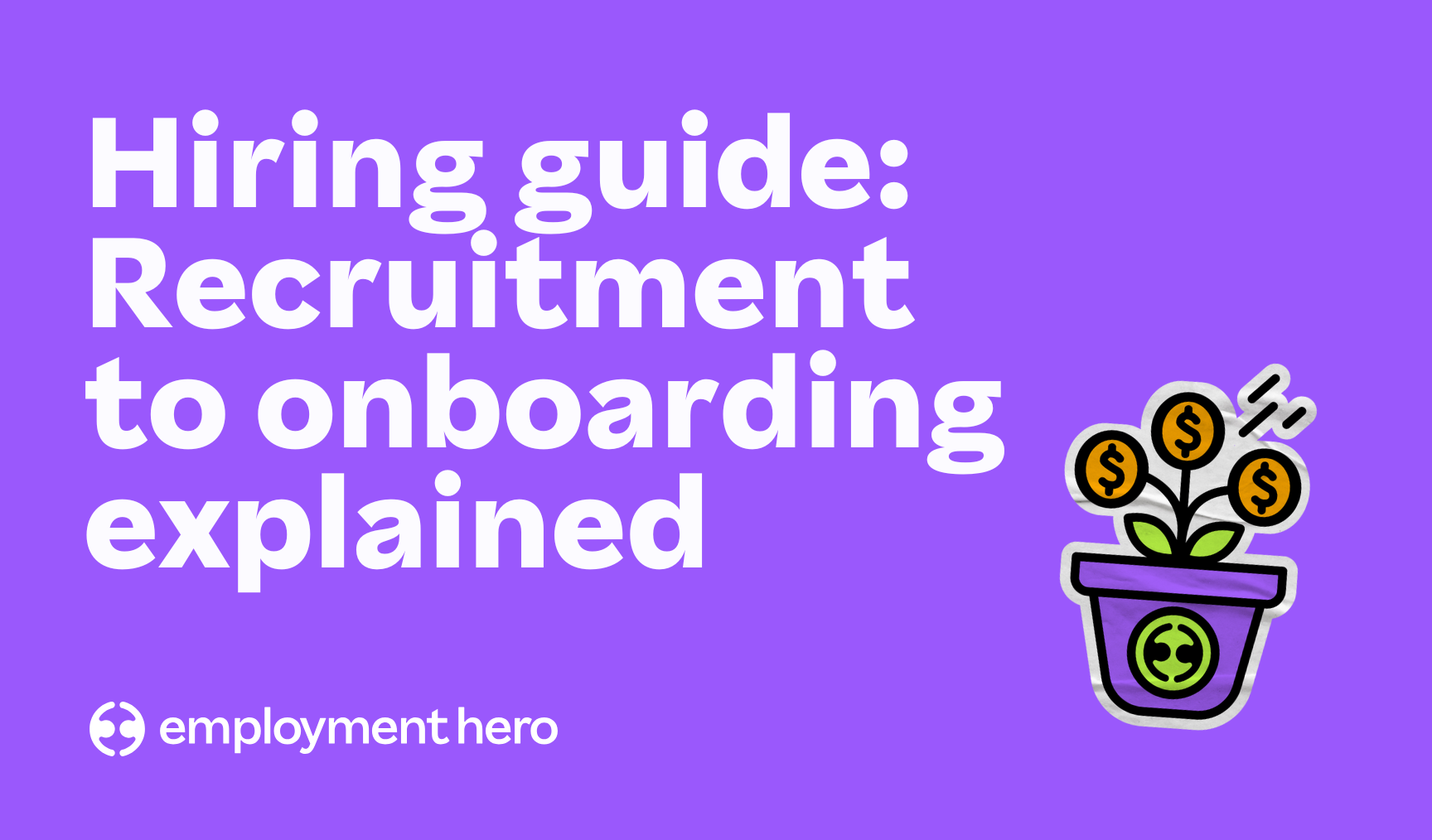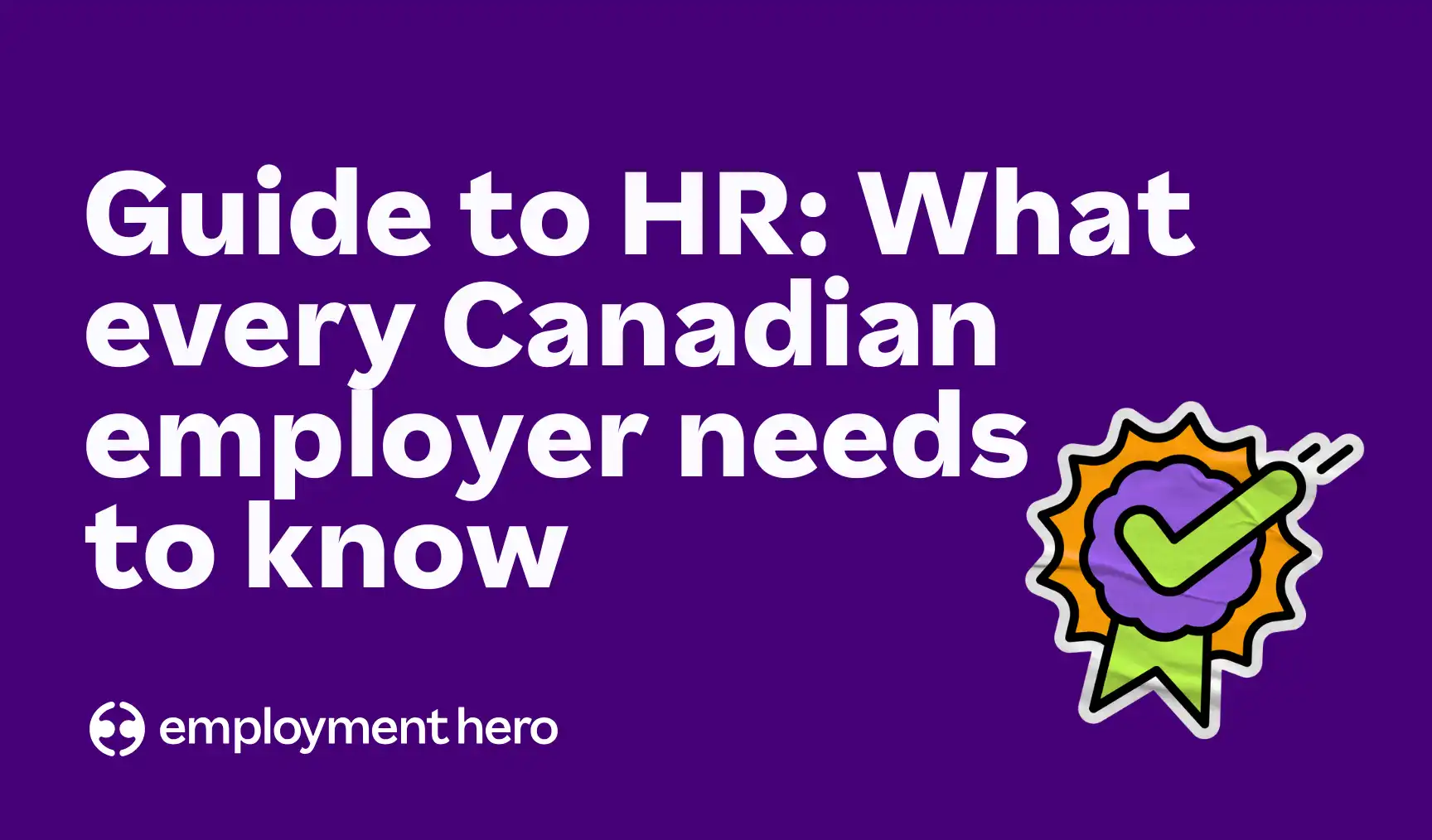An employer’s guide to written warning (+Free template)
Published
An employer’s guide to written warning (+Free template)
Published
In effective performance management, clear communication is essential. A written warning letter is a formal, documented step taken by an employer when an employee’s conduct or performance falls below the expected standard. It is a critical tool for giving the employee a clear opportunity to improve while also protecting the employer from legal exposure.
A written warning serves a dual purpose: it clearly defines the problem, expected changes and consequences for the employee, and it creates a necessary paper trail for the employer, especially if further disciplinary action is required.
This guide details the proper use of written warnings and the legal considerations for Canadian employers. We offer a free, downloadable written warning letter template designed to help you issue compliant, fair and clear disciplinary notices.

What is a written warning?
A written warning is an official disciplinary step used in progressive discipline. Its primary purpose is to notify an employee formally of a specific breach of company policy, a performance deficiency or unacceptable conduct.
It is typically issued after verbal warnings or informal coaching have failed to correct the issue. It’s a formal escalation that signals the seriousness of the issue and the necessity of immediate, demonstrable improvement.
Its importance lies in both performance management and legal compliance. In performance management, it sets clear performance standards and a timeline for correction. Legally, a well-documented series of warnings (known as the progressive discipline process) is essential to demonstrate that an employer provided a fair chance for improvement before resorting to termination for cause.
First warning vs final warning: When should you issue one?
Progressive discipline means that penalties increase in severity with repeated or more serious infractions. The most common stages are the first written warning and the final written warning.
| Feature | First written warning | Final written warning |
|---|---|---|
| When to issue | First instance of a minor performance issue (e.g., occasional lateness, minor errors, failure to follow a procedure). | Second or subsequent instance of the same or related issue OR a single instance of a serious breach of conduct (e.g., insubordination, serious policy violation). |
| Purpose | To officially notify the employee, set clear expectations, and establish a paper trail for the first offence. | To notify the employee that their employment is now at risk. It is the last chance for correction before termination. |
| Key message | “Improvement is required; failure to improve may lead to further disciplinary action.” | “Immediate, sustained improvement is required; failure to comply will lead to termination of employment.” |
| Reference to past | May reference prior verbal warnings or coaching sessions. | Must reference the date(s) of the previous written warnings. |
Understanding the written warning procedure in Canada
To ensure fairness and legal compliance, employers should follow a standardized, step-by-step procedure when issuing a written warning:
- Investigate and document: Before any meeting, gather all facts, evidence and documentation regarding the alleged misconduct or poor performance.
- Hold a disciplinary meeting: Meet privately with the employee (and often an HR representative). Clearly state the specific allegations, referencing dates and specific incidents. Give the employee a fair opportunity to explain or respond to the allegations—this is crucial for natural justice.
- Consider the response: After the employee provides their response, take time to consider it carefully. This step, reflected in our template, shows you did not issue the warning unilaterally or unfairly.
- Issue the written warning: If the decision is to proceed, issue the formal letter. The letter must be dated and signed, detailing the reasons for the warning, the required improvement and the consequences of failing to meet the standards.
- Obtain acknowledgement: Ask the employee to sign the letter (as provided in our template) to acknowledge receipt. If they refuse to sign, note their refusal on the document with a witness signature.
- Follow-up and support: Implement the performance improvement plan (if applicable) and schedule follow-up meetings to support and monitor the employee’s progress.
Legal considerations employers should know
In Canada, disciplinary actions, including written warnings, are governed by the common law principle of progressive discipline and by provincial employment standards legislation (e.g., the Employment Standards Act, 2000 in Ontario).
Progressive discipline and “just cause”
For an employer to dismiss an employee with just cause (meaning without providing notice or severance), they must typically demonstrate a long history of documented performance issues. Written warnings provide the evidence that the employee was clearly notified of the problem, given a chance to improve and failed to do so. Without this documentation, termination for cause is extremely difficult to defend.
What to include in a written warning
A legally sound warning letter must include the following components to ensure fairness and compliance:
- Date and delivery method: The date the warning is issued and how it was delivered (in person, by email, etc.).
- Reference to the disciplinary meeting: Confirmation of the date the discussion was held and that the employee was given an opportunity to respond to the allegations.
- Specific allegations: Clear, factual details of the conduct or performance issues, referencing policies or standards that were breached.
- Employee’s response summary: A brief, objective summary of the employee’s explanation or response from the meeting.
- Formal decision and specific areas of concern: The formal decision to issue a warning and a focused list of the areas requiring immediate improvement.
- Reference to previous warnings (if applicable): If this is a final warning, list the dates of prior formal warnings.
- Clear consequence statement: A non-negotiable statement outlining the penalty for continued failure to improve (i.e., further disciplinary action, up to and including termination of employment).
- Acknowledgement section: A space for the employee to sign to confirm receipt.
Download our free written warning template
Don’t risk legal action due to vague or incomplete documentation. Our written warning letter template for Canadian employers is built to include all the legally necessary components of progressive discipline.

Best practices for employers
Follow these recommendations to ensure your progressive discipline process is fair, effective and legally sound:
- Be specific and objective: Never use vague or subjective terms like “bad attitude.” Always link the issue to quantifiable failures (e.g., “Missed three deadlines”) or specific policy breaches.
- Maintain consistency: Apply disciplinary action consistently across all employees. Inconsistent application of rules can expose you to discrimination claims.
- Focus on the future: The warning should be constructive. Clearly articulate the expected standard and offer any necessary support, training, or resources to help the employee meet it.
- Document everything: Keep a copy of the written warning, all supporting evidence (e.g., attendance records, emails) and the employee’s signed acknowledgement in their personnel file.
- Seek legal advice for termination: Before moving from a Final Written Warning to termination, always consult with an employment lawyer to review your documentation and ensure you have “just cause” under Canadian common law.
Moving forward after a warning
The written warning letter is an indispensable component of responsible and legally defensible employee management. By issuing clear, documented and progressive warnings, you create a framework for employee success while protecting your business against claims of unfair dismissal.
Frequently asked questions
A written warning formally documents an employee’s failure to meet standards. The employee is required to demonstrate immediate and sustained improvement in the areas specified in the letter. If they succeed, the disciplinary process ends. If they fail to improve, they are subject to further action, which often leads to a final written warning or termination.
A first written warning is serious because it is the first formal, documented step toward potential job termination. While it generally doesn’t put the job immediately at risk, it clearly signals that the previous informal coaching has failed and that the employee’s performance file now contains an official disciplinary record.
There is no set legal expiry date, but many Canadian companies maintain a policy stating that warnings expire after a period of satisfactory performance, typically 12 to 18 months. If a new infraction occurs after the expiry period, the employer may issue a first written warning again, rather than escalating immediately.
Yes. An employee can formally dispute the facts or fairness of the warning. This is why the formal meeting and the section in the letter summarizing their response are critical. If they are a unionized employee, they can file a grievance. Non-unionized employees may raise a formal complaint internally or, in some cases, argue in a wrongful dismissal claim that the warnings were baseless.
Typically, a first written warning is followed by a final written warning if the poor performance continues. A final written warning is then followed by termination of employment if the required improvement is not met within the specified timeframe.
The information in this template is current as at 1 September 2025, and has been prepared by Employment Hero Pty Ltd (ABN 11 160 047 709) and its related bodies corporate (Employment Hero). The content is general information only, is provided in good faith to assist employers and their employees, and should not be relied on as professional advice. Some information is based on data supplied by third parties. While such data is believed to be accurate, it has not been independently verified and no warranties are given that it is complete, accurate, up to date or fit for the purpose for which it is required. Employment Hero does not accept responsibility for any inaccuracy in such data and is not liable for any loss or damages arising directly or indirectly as a result of reliance on, use of or inability to use any information provided in this template. You should undertake your own research and seek professional advice before making any decisions or relying on the information in this template.
Register for the template
Related Resources
-
 Read more: Hiring guide for Canadian employers: From recruitment to onboarding
Read more: Hiring guide for Canadian employers: From recruitment to onboardingHiring guide for Canadian employers: From recruitment to onboarding
Learn how to hire in Canada. This hiring guide walks employers through job postings, interviews, contracts, compliance checks & onboarding…
-
 Read more: Hiring guide for Canadian employers: From recruitment to onboarding
Read more: Hiring guide for Canadian employers: From recruitment to onboardingHiring guide for Canadian employers: From recruitment to onboarding
Published Published If you’re running a business in Canada, you’re already aware of the complexities of HR (Human Resources) and…
-
 Read more: Seasonal hiring in Canada: Retail and hospitality best practices
Read more: Seasonal hiring in Canada: Retail and hospitality best practicesSeasonal hiring in Canada: Retail and hospitality best practices
Discover how to manage seasonal hiring. Learn compliance requirements, contracts, pay rules and retention strategies for retail and hospitality workers.

















